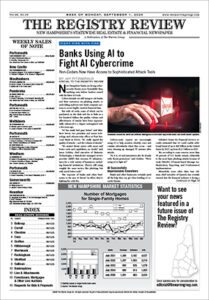
Chair Jerome H. Powell (left) and Vice Chair Philip N. Jefferson participate in the Federal Reserve’s interest rate-setting Federal Open Market Committee (FOMC) meeting at the William McChesney Martin Jr. Building in Washington, D.C., held on Jan. 30-31, 2024. Photo courtesy of the Federal Reserve
Intense competition for deposits among banks may limit the benefits they receive from any interest rate cuts by the Federal Reserve this year.
There’s little doubt short-term interest rate cuts, if and when they occur, would help consumers via lower variable rates for home equity lines of credit, auto loans, credit cards and mortgages, New Hampshire bankers say.
Likely cuts won’t come close to bringing rates down to levels last seen in early 2022, before the Fed started aggressively raising rates from historic lows in order to combat inflation.
Lower-but-still-stubborn inflation forced the Fed to delay cutting rates early this year, but many expect it to take action to reduce rates by late this year, assuming inflation is near the Fed’s target goal of about 2 percent.
Even if there’s only a small, quarter-point reduction in the central bank’s benchmark interest rate – now predicted no sooner than May by many economists – a cut could still help consumers with lower borrowing costs, bankers say.
“It would provide some relief,” said Marcus Weeks, president of Meredith Village Savings Banks. “For borrowers, they’ll benefit from lower variable rates. Depending how low [rates] go, they will feel some effect.”
Consumers, Companies Could Benefit
Interest-rate relief would not only help individual consumers, but also help companies, big and small, via lower rates for general business loans and refinancings for commercial properties.
Amid today’s higher interest rates, some businesses have hesitated taking out various loans. But that could change if rates come down a bit.
“You could see some businesses reconsider their past decisions” not to borrow, said Weeks, whose bank has total assets of $1.6 billion and 13 branches in the region.
Banks themselves would also see some benefits from lower short-term interest rates.
Chris Logan, president and CEO of Bank of New Hampshire, noted a fall in short-term rates would reduce banks’ overnight borrowing costs.
“It helps lower some of our costs of funds,” said Logan, whose bank has $2.5 billion in assets and 21 branches.
But that doesn’t mean a rate cut will immediately lower all costs for banks.
Logan noted that interest rates on short-term debt – particularly U.S. Treasury bonds – are currently higher than rates on longer-term debt, creating an “inverted yield curve” that’s vexing and frustrating bankers. Normally, long-term rates are higher than short-term rates.
“That’s the challenge now to banks,” Logan said of current yield curve conditions. “It’s driving up our costs.”
The question is what happens to long-term rates if short-term rates come down. No one really knows, Logan says.
Intense Competition for Deposits
Such challenges come amid intense competition among banks to attract and keep depositors – and that competition will likely keep up deposit rates for certificates of deposit and other higher-yield deposit types even if the Fed lowers its short-term rates.
“It’s very competitive out there,” Logan said of the battle for deposits. “I don’t see that changing.”
As a result, any cost benefits to banks of lower Fed rates may take time to play out.
“I don’t think deposit costs will come down as far as [Fed] rates,” said Meredith Village’s Weeks. “It’s not going to be an instant benefit for us.”
Weeks added: “It will take time to lower our cost of funds.”
There’s also questions about whether lower short-term rates would impact the housing market – and boost mortgage-related business for banks.
Currently, demand for housing across New Hampshire remains strong, but inventories of single-family homes and condominiums for sale have been at historic lows.
One of the main reasons for low inventories: the reluctance of potential sellers, many of whom live in homes with super-low pre-2022 mortgage rates, to put their homes on the market if buying a new abode entails paying significantly higher mortgages rates.
Weeks said lower rates could spur some sellers to finally put their homes on the market.
“When rates come down, maybe that logjam will break up a bit,” he said.
Banks may also see a small bump in re-fi activity, he said.
Will It Unstick the Housing Market?
But others say a small interest rate cut, even a few small cuts, won’t be enough to change the current housing market.
“The problem is a shortage of homes,” said Joanie McIntire, associate broker at Coldwell Banker-J Lampe and president of the New Hampshire Association of Realtors. “We just need more housing.”
She expressed doubt that slightly lower rates might spur potential sellers to finally put their homes up for sale.
“They still need to find a new home to move into,” she said. “I’m not sure lower rates will impact things much.”
As for the impact of lower rates on the economy as a whole, the thinking is that lower borrowing costs spur consumer spending. Or at least that’s the theory.
Logan said he wonders if that consumer-spending assumption still holds true, based on the fact consumer spending actually continued to increase while rates rose, partly due to households still having some pandemic-era recovery dollars to spend.
“We’ve kind of broken the old model,” Logan said. “Our spending habits were modified.”
Weeks said that lower interest rates may help the economy. But rates are usually lowered to “spur an already falling economy,” he said.
All the talk about the benefits, and non-benefits, of rate cuts may be moot if inflation stays higher than expected and the Fed opts to keep rates where they are now, bankers agree.
“It’s a balancing act,” Logan said. “The Fed is fighting inflation while at the same time it’s trying to keep the economy from falling into recession. It’s an incredibly difficult balancing act.”

